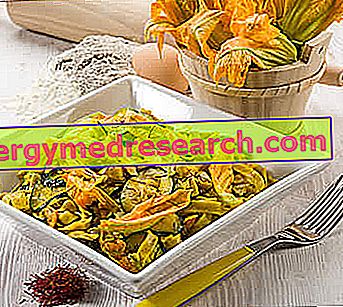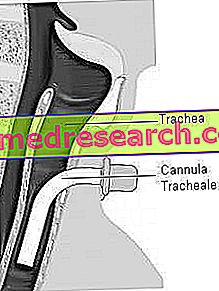What is the Flower?
By "flower" we mean the reproductive organ of some Angiosperm plants.
The job of the flower is to guarantee fertilization, from which the seed will ripen (fruit or part of it).
The structure of the flower varies according to the type of plant, but in the most complicated cases it includes four components:
- Chalice: sterile photosynthetic green leaflets.
- Corolla: sterile non-photosynthetic colored petals.
- Gineceo: or pistil, is the fertile female part.
- Androceus: is the fertile male part.

Flowers in the Food
Like other parts of the plant, flowers can also be edible or edible.

Some flowers lend themselves to raw consumption, while others gain greater organoleptic characteristics through cooking.
It is important to specify that the edible part of the flowers is not the same for all plants. At best the flower is totally edible. For some varieties it is required to remove the stem and / and the androcean and the gynaeceum. On the other hand, there are also flowers of which the most valuable portion is constituted by the reproductive organs.
Nutritional Properties
As anticipated, the flowers are considered vegetables or vegetables, or spices.
From the nutritional point of view they belong to the VI and VII group of foods, therefore they are distinguished by the considerable content of provitamin A (retinol equivalent) and / or vitamin C (or ascorbic acid).
Other typical nutrients of edible flowers are: glucose, fiber, potassium, polyphenolic antioxidants and essential oils.
Compared to most sweet fruits (apple, pear, peach, apricot, grapes, khaki, banana, plum, etc.), edible flowers should provide fewer calories.
There is no real recommendation concerning the consumption of edible flowers, but it is possible to hypothesize that both the portion and the frequency concur to cover those recommended for vegetables or vegetables (2-4 portions of 50-300g every day).
Below is the nutritional detail of some edible flowers traditionally consumed in Italian gastronomy.
| Chemical composition | Value for 100g | |||||
| Turnip tops | Broccoli | Artichoke | Cauliflower | Courgette flowers | ||
| Edible part | 60g | 51, 0g | 34, 0g | 66, 0g | 79, 0g | |
| water | 91, 4g | 92, 0g | 91, 3g | 90, 5g | 94, 3g | |
| Protein | 2, 9g | 3.0g | 2, 7g | 3, 2g | 1, 7g | |
| Limiting Amino Acid | - | - | - | - | - | |
| Total lipids | 0.3g | 0.4g | 0.2g | 0.2g | 0.4g | |
| Saturated fatty acids | - | - | - | - | - | |
| Monounsaturated fatty acids | - | - | - | - | - | |
| Polyunsaturated fatty acids | - | - | - | - | - | |
| Cholesterol | 0, 0mg | 0, 0mg | 0, 0mg | 0, 0mg | 0, 0mg | |
| Carbohydrates available | 2.0g | 3, 1g | 2.5g | 2, 7g | 0.5g | |
| Starch | 0.0g | 0.0g | 0.5g | 0.3g | 0.0g | |
| Soluble sugars | 2.0g | 3, 1g | 2.0g | 2.4 g | 0.5g | |
| Total fiber | 2, 9g | 3, 1g | 5.5g | 2.4 g | - | |
| Soluble fiber | 0, 61g | 0, 84g | 4, 68g | 0, 71g | - | |
| Insoluble fiber | 1, 59g | 2, 42g | 3, 17g | 1, 68g | - | |
| Phytic acid | - | - | - | - | - | |
| Alcohol | 0.0g | 0.0g | 0.0g | 0.0g | 0.0g | |
| Power | 22, 0kcal | 27, 0kcal | 22, 0kcal | 25, 0kcal | 12, 0kcal | |
| Sodium | - | 12, 0mg | 133, 0mg | 8, 0mg | - | |
| Potassium | - | 340, 0mg | 376, 0mg | 350, 0mg | - | |
| Iron | 1.5mg | 0.8 / mg | 1.0 mg | 0, 8mg | 2, 0mg | |
| Football | 97, 0mg | 28, 0mg | 86, 0mg | 44, 0mg | 39, 0mg | |
| Phosphorus | 69, 0mg | 66, 0mg | 67, 0mg | 69, 0mg | 37, 0mg | |
| Magnesium | - | - | 45mg | 28, 0mg | - | |
| Zinc | - | - | 0, 95mg | 0, 70mg | - | |
| Copper | - | - | 0, 28mg | 0, 13mg | - | |
| Selenium | - | - | - | tr | - | |
| Thiamine | 0, 04mg | 0, 04mg | 0, 06mg | 0, 10mg | 0, 09mg | |
| Riboflavin | 0, 16mg | 0, 12mg | 0, 10mg | 0, 10mg | 0, 16mg | |
| Niacin | 1, 00mg | 1, 80mg | 0, 50mg | 1, 20mg | - | |
| pyridoxine | - | - | - | - | - | |
| Vitamin A retinol eq. | 225, 0μg | 2, 0μg | 18, 0μg | 50, 0μg | 252, 0μg | |
| C vitamin | 110, 0mg | 54, 0mg | 12, 0mg | 59, 0mg | 28, 0mg | |
| Vitamin E | - | - | 12, 0mg | - | - | |
| Vitamin D | - | - | - | - | - | |
Other edible flowers of marginal importance belong to: Genus Allium (garlic, onion, leeks, etc.), Dill, Angelica, Basil, Borage, Calendula, Chervil, Chicory, Genus Citrus (lemon, orange, grapefruit, etc.), Coriander, Chrysanthemum, Tooth of Lion, Fennel, Cornflower, Carnation, Sunflower, Gladiolus, Hibiscus, Impatiens, Anise, Lilac, Hollyhock, Margherita, Mint, Monarda, Ribbon, Passionflower, Rosemary, Radish, Rose, Arugula, Sage, Trefoil, Verbena, Viola.
Culinary aspects
It is not possible to establish generalized recommendations on cooking methods and flower processing.
These are foods with chemical and physical characteristics that are so different that they must be described individually.
Some edible flowers are eaten raw and others cooked. Some are consumed together with the stem of the plant, another category without a stem. Some are deprived only of the reproductive system.
The flowers of the varieties belonging to the Brassica genus and oleracea species (turnip greens, broccoli, cauliflower, etc.) are entirely edible and are consumed together with the stem of the plant; only the leaves and the root system are excluded (sometimes the superficial layer of the bark). They brilliantly hold up cooking and lend themselves to systems such as: boiling, steam, pressure; sometimes the recipes also include au gratin, frying and other processing (preservation in oil, pickled).
The small flowers of the artichoke are almost entirely edible, while they have a very important fibrous waste at an advanced stage. This is not made chewable even by cooking and is rather indigestible. The stem is always edible.
Pumpkin and courgette flowers, on the other hand, are completely edible; someone suggests eliminating the reproductive system (stamens and pistils) potentially responsible for a bitter aftertaste. They lend themselves to very fast cooking such as: stir-frying, frying with batter and fast gratin.
- Recipes with Pumpkin Flowers
- Recipes with rose petals
- Recipes with saffron
- Recipes with Broccoli
- Recipes with Artichokes
- Recipes with Cauliflower
Recommendations
Let us not forget that plant organisms are capable of producing toxic or otherwise harmful molecules for the body (sometimes only if ingested in excessive quantities). The poisonous substance can affect the whole plant, only the fruits / seeds, roots or leaves. Some examples are: oleander, stramonio, belladonna, macinella, aconite, badger, castor, abro, hemlock, ivy, mistletoe and jasmine.
It is advisable to eat ONLY the flowers that are certainly edible and avoid experimenting in person; there is also the possibility of consulting specific texts.
Furthermore, the plants that produce the flowers to eat should not be grown with the same techniques aimed at the ornamental purpose. Greenhouses, garden and florists often use toxic chemicals (pesticides) to keep the plant healthy; however, this could harm the human body. It is advisable to produce the edible flowers independently or buy them from specific sources.
For similar reasons (which also imply pollutant concentrations) it is not advisable to take edible flowers on the street and in other people's or public gardens.
WARNING! In the case of specific allergies, such as pollens, consult an allergist before use and proceed with caution.



